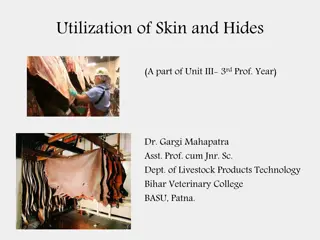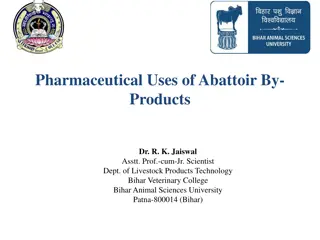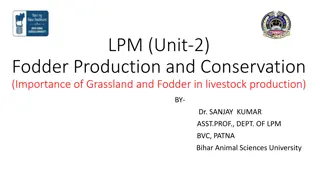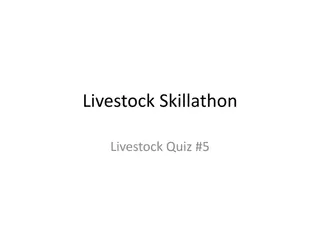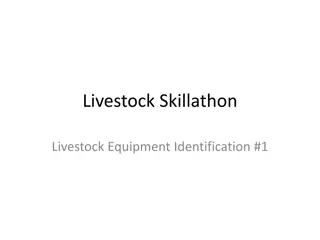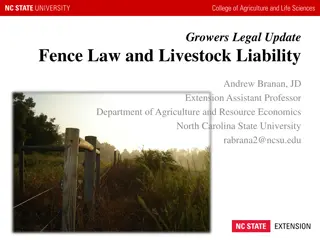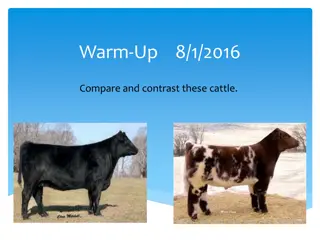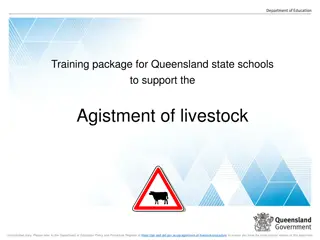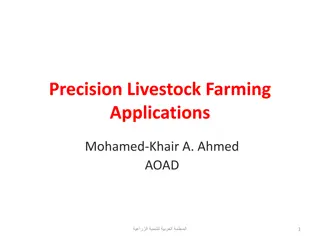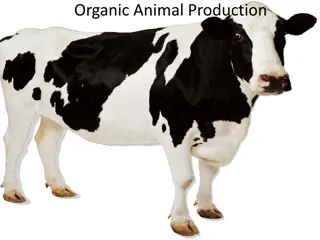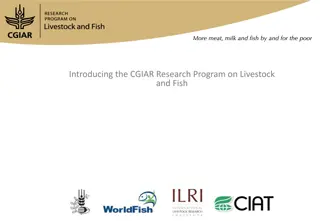Abattoir Practices and Animal By-Products in Livestock Industry
Abattoir practices and animal by-products play a vital role in the livestock industry, with more than 100 million animals slaughtered annually in India. By-products such as organs, bones, hide, and more are generated, with the potential for revenue generation. Effective utilization of these by-products is crucial to avoid wastage and prevent public health issues. Edible and inedible by-products are classified based on consumer preferences and customs, highlighting the importance of maximizing returns on these resources.
Download Presentation

Please find below an Image/Link to download the presentation.
The content on the website is provided AS IS for your information and personal use only. It may not be sold, licensed, or shared on other websites without obtaining consent from the author. Download presentation by click this link. If you encounter any issues during the download, it is possible that the publisher has removed the file from their server.
E N D
Presentation Transcript
Unit III - ABATTOIR PRACTICES AND ANIMALBY-PRODUCTS TECHNOLOGY Department of Livestock Products Technology Bihar Veterinary College Bihar Animal Sciences University Patna-800014 (Bihar)
Abattoir by-products India have vast livestock resources (535.82 million). More than 100 million animals are slaughtered every year in 3,900 licensed & authorized slaughter houses besides around 26,000 unauthorized slaughter houses. Slaughter rate for cattle as a whole is 20%, for buffaloes it is 41%, pigs 99%, sheep 30% and 40% for goats. Besides meat a large quantity of by-products are produced , it includes every part of a slaughtered animal except dressed carcass
Cont Meat is the primary products of livestock industry and constitute majority of economic value. The key to the greater profit is to earn higher returns on by products The quantity of animal by-products available for utilization can be estimated by subtracting the dressing percentage from 100. The yield from meat animals during the slaughter process of non-edible outputs ranges from 20 to 30% of the live weight for beef, pork and lamb and from 5 to 6% of the live weight of chickens.
Cont. The income from by products ranges form 7-12% of total income of slaughter By-products are generated processors, wholesalers, retailers and renderers If the animal by-products are not effectively utilized, a valuable source of potential revenue is lost and increasing cost of disposal of this products Non utilization of animal by-products create a major aesthetic and catastrophic public health problems by slaughterers,
Cont Some of the by-products are organs, such as kidney, brain, liver, heart, lungs and intestinal tract, gullets and sweet bread, stomach, blood, bones, hooves, horns, hair and bristles, hide and skin, etc. Animals, which die at abattoir prior to slaughter, or those animals or parts of animals, which have failed to pass meat inspection consumption, are also included in the by-products. Ears, lips, snouts, teeth, trimmings, fleshing and dew claws are also listed under by-products. as, fit for human foetus, gall bladder,
Cont. Organs such as kidney, brain, liver, heart and tongue are classified as edible by-products while the others are classified as inedible by-products. The basic factors making the deviation between edible and inedible products are determined by the purchasing power of the consumer, his food habits, religious taboos and customs. On the border line between these two extremes is a small group of organs which depending upon the food customs and purchasing power of the consumer may be considered either edible or inedible.
Approximate yield (% of live weight) of meat by-products from large animals (Buffalo and Cattle) Bone, head and feet Paunch content and waste Hide Other offal (udder tail etc.) Blood Casings Lung, Oesophagus Fat liver Stomach Heart Tongue Spleen Kidney Meat (bone less) 28% 22% 16% 7.5% 4% 3.14% 2% 2% 1.71% 1.42% 0.71% 0.42% 0.28% 0.28% 0.14%
Classification of abattoir by-products 1. According to origin a. Principal by-products: These are directly harvested from the animals. e.g. hide and skin, blood, bones, hooves and horns b. Secondary by-products: These are derived from principal by-products. e.g. blood meal, fibrin, haemoglobin, blood albumin, serum, plasma and so on from blood; fat yields glycerin and soap; bones yield gelatin and nitroglycerine, hides yield leather shoes, bags, belts, clothing, etc.
Cont 2. According to use as a food a. Edible by-products: liver kidney, heart, brain, intestine, thymus, tongue, spleen, meat trimmings, fat etc. b.Inedible by-products: hide, skin, ear, lips, snout, gall bladder, fetus, hoofs, horn hair, bristles etc.
Cont 3. According to ultimate use a. Agricultural by-products: meat meal, bone meal, fertilizers, etc. b.Industrial by-products: Gelatin, glue, casings, etc. c. Pharmaceutical biochemicals, hormones, etc. by-products: Insulin, pepsin,
Advantages of utilization of abattoir by-products It protects the environment from pollution Ensures better returns to the livestock producers Helps in supply of highly nutritive feed for more productive livestock Helps in setting up of secondary rural industry Generate new employments Increase the crop production
Requirements for profitable processing of abattoir by-products Ensure adequate supply of raw material collection Provision of cheap and satisfactory storage facilities for perishable materials Development of practical commercial processes for manufacturing of derived products Availability of potential market Technical training of personnel
Plan and layout of abattoir by-products utilization plant In our country due to huge livestock density, at least one animal byproducts processing plant at each 50km range is necessary Consideration during establishing of abattoir by- products utilization plant: 1. It should be adjacent to the slaughter house or a part of the same building connected through gravity pipe or passage 2. Should be away from inhabited area 3. Should be provision of overhead rails from slaughter house to the by-products plant
Cont. 4. Should have own screened drainage system 5. Should have separate clean (exit point) and unclean (inlets) area 6. Smooth concrete floor, wall and ceiling (floor slope of per ft. is recommended). 7. Should have a hide/skin, salting room, renderers, tripery, manure bunker, store etc. 8. Open and well ventilated to prevent humidity build up 9. The equipments to be installed should cope up with by-product or offal processing.
Abattoir by-products utilization plant Three main section should be there: 1. Hide/skin section with salt store 2.Tripery/Gut processing section with cleaning tables, water taps etc. 3. Carcass utilization plant with renderer, bone digester, fat settling tank and adjoining milling room and store. Besides boiler, worker lockers, amenities and adjacent manure pit are other important requirements.
Cont. The boiler should be of suitable capacity keeping in view the availability of raw material; and consumption of renderer. The requirement of steam has been worked out to be 1.25 lb per lb of raw material to be processed.
Dead/fallen animals Large animals are die due to natural causes such as disease etc. Condemned materials from slaughter house is also available It is necessary to hygienically dispose the fallen animals to avoid decomposition and formation of obnoxious gases Transport of fallen animals is done using road transport mode such as bullock cart or tractor trolleys
Cont The floor of the vehicle is should be bedded with straws and made free from any projection, otherwise bruising of the hide or skin will be there, lowers the cost of materials The transport of the condemned animals should be in closed vehicle to by-products plant The vehicle may be labeled as carrying as inedible animals by-products
Utilization of dead/fallen animals Raw material for carcass utilization plant Carcass pieces, bones, heads, feets, lungs, trachea, spleen, intestine (without contents), trimmings, genitals, udder, foetus, tripes Not includes hoofs, horns, hair, blood, stomach or intestinal contents
Composition of various stock feeds Meat meal: Carcass meal (meat cum bone meal) Protein Phosphorus Bone meal (steamed) Protein Calcium Phosphorus Protein- Protein and minerals- Moisture Crude fat Phosphorus >55% 85% 7% 8% <4.5% <55% >4.5 32.5% 7% 15%


